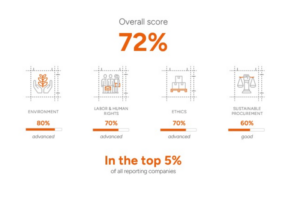Reuse and Recycling: The Future of Office Refurbs
A well-delivered office refurbishment can refresh a tired workspace and be sustainable too.
In addition to this, it should also make the workspace work harder and support an organisation with their CSR and sustainability goals.
Traditionally, an office refurbishment has meant out with the old and in with the new. Office furniture has often been treated as a short term disposable item.
However, businesses are now finding that integrating reuse and recycling into office refurbishment can help deliver improved working environments whilst making cost savings on more traditional approaches.
Money saved can be then be diverted to create a better meeting, break out and recreational areas, benefiting both the employees and the employer.
Overcoming barriers to reuse
Facility Managers can present barriers to this more sustainable approach to refurbishment with concerns about the quality and reliability of reused office furniture. Similarly, they can be worried about how staff will perceive a reuse solution.
However, providers of good quality remanufactured and refurbished office furniture can be expected to provide warranties giving confidence to the specifier.
Installing a trial remodelled desk, screen, chair and producing information on the sustainable financial and environmental savings can also help change this perception when staff and stakeholders can see first-hand the quality of finish that can be achieved
Remodelling office desks
With the move to more agile working environments, there follows a requirement to replace traditional desking with team tables or more flexible workspaces. Remodelling existing desk to meet new office layouts makes the most of the quality furniture in which organisations have already invested.
Remodelling an office desk can deliver significant cost saving, with costs typically 70% less than an equivalent new desk and for every 10 office desks remodelled you are saving 1 tonne of C0 2 (e).
Wider reuse opportunities
Acoustic screens and notice boards can be reupholstered to match new colour schemes, incorporating greater vibrancy into an office and achieving a consistent look that incorporates brand themes.
Reuse can also be considered as a sustainable and cost-effective alternative for many other items of the infrastructure. Carpet tiles can be re-patched in high wear areas, similarly not all ceiling tiles need to be replaced. Receptions desks, cupboards and doors can all be resized to meet new design criteria.
Additional reuse can help reduce the overall budget, reduce environmental impact and help an FM spend budget in areas of greatest need.
Dealing with unwanted furniture
When clearing redundant items from an office clearance, reuse should certainly be prioritised, either by your own organisation, other businesses or those in greater social need.
Good quality office furniture can be provided for resale, contributing towards the budget for a refurbishment.
Furniture and equipment can be donated to schools, charities and social enterprises. This benefits the recipients and contributes to an organisation’s corporate social responsibility agenda.
A single comprehensive solution from your service provider can deliver, and report back on, these environmental, financial and social outcomes with no additional burden on the time-poor Facility Manager.
The way forward
With sustainability creating a huge challenge for Facility Managers, integrating reuse and recycling into refurbishment provides a great opportunity to combine environmental and social benefits.
This includes cost savings and generating an even greater feel-good factor in the office than a traditional refurbishment.
Five things you might not know about reuse
- Approximately 1.2 million office desks and 1.8 million office chairs end up in UK landfill each year
- A remanufactured desk cost typically 30% or less than the cost of a new desk
- Remanufactured products can come with one to five-year warranties equivalent to new products
- Simple reuse of an office desk can cut its carbon footprint by 36% and replacement of just the desktop cuts its footprint by 18%
- Refurbishment/repair of an office chair can reduce its carbon footprint by 45%
Figures from Waste and Resource Action Programme (WRAP)– Benefits of Reuse A Case Study Office Furniture 2011 and www.wrap.org.uk.
Related stories
Crown are delighted to announce that we have been awarded Gold by EcoVadis in 2024 for the second time, reflecting our commitment to and progress in becoming a responsible business.
We supported both Landaid and the YMCA with cardboard boxes for their annual sleepout events. We were incredibly pleased to deliver 1,100 boxes as well as bring along a group of volunteers to the YMCA event.
Crown UK&I are incredibly pleased to have maintained a B score in the ‘Management’ band with CDP this year. This demonstrates our co-ordinated action on climate change issues and reflects our continued progress against an ambitious and holistic sustainability strategy implemented across our UK&I brands.




















